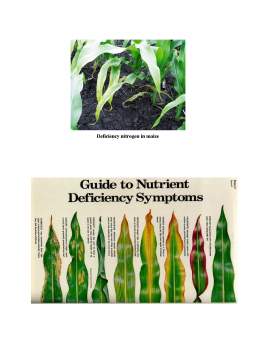Extras din proiect
There are 16 nutrient elements required to grow crops. Three essential nutrients carbon (C), hydrogen (H) and oxygen (O), are taken up from atmospheric carbon dioxide and water. The other 13 nutrients are taken up from the soil and are usually grouped as primary nutrients, secondary nutrients and micronutrients.
The primary nutrient - nitrogen (N), phosphorus (P) and potassium (K),are commonly found in fertilizers. Primary nutrients are utilized in the largest amounts by crops, and therefore, are applied at higher rates than secondary nutrients and micronutrients.
The secondary nutrients - calcium (Ca), magnesium (Mg) and sulfur (S), are required in smaller amounts than the primary nutrients. The major source for supplementing the soil with calcium and magnesium is dolomitic lime (aglime), although these nutrients are also available from a variety of fertilizer sources. Sulfur is available in fertilizers such as potassium and magnesium sulfate, gypsum (calcium sulfate) and elemental sulfur.
Micronutrients - iron (Fe), manganese (Mn), zinc (Zn), copper (Cu), boron (B) and molybdenum (Mo), are required in even smaller amounts than secondary nutrients. They are available in manganese, zinc and copper sulfates, oxides, oxy-sulfates and chelates, as well as in boric acid and ammonium molybdate.
Nitrogen's Role
Of the three major nutrients, plants require nitrogen in the largest amounts. Nitrogen promotes rapid growth, increases leaf size and quality, hastens crop maturity, and promotes fruit and seed development. Because nitrogen is a constituent of amino acids, which are required to synthesize proteins and other related compounds, it plays a role in almost all plant metabolic processes.
Nitrogen is an integral part of chlorophyll manufacture through photosynthesis. Photosynthesis is the process through which plants utilize light energy to convert
atmospheric carbon dioxide into carbohydrates.
Little of the applied nitrogen is carried over to subsequent growing seasons due to crop removal, leaching and denitrification. Of all the elements required for crop production, nitrogen poses the greatest environmental threat through contamination of surface and ground water.
Nitrogen fertilizer is available in both organic (manures) and inorganic forms. The amount of nitrogen in organic sources varies with source material and its state of decomposition. However, for commercial crop production, the following inorganic fertilizers are primarily used: ammonium nitrate (33.5%N), potassium nitrate (13% N), sodium nitrate (16% N), calcium nitrate (15.5% N), urea (46% N), mono-ammonium phosphate (18% N), di-ammonium phosphate (46% N) and liquid nitrogen (30% N and 10-34-0).
Legume crops require little or no nitrogen fertilizer. Beneficial bacteria that live in the roots of these plants capture nitrogen from the atmosphere. This nitrogen is available for use by the plant. Nitrogen is also used by microbes to break down organic matter.
Nitrogen Deficiency
Nitrogen-deficient plants exhibit slow stunted growth, and their foliage is pale green. Deficiency symptoms generally appear on the bottom leaves first. In severe cases, the lower leaves have a “fired” appearance on the tips, turn brown, usually disintegrate, and fall off.
In leafy crops such as tobacco, vegetables, forage and pasture crops, low nitrogen results in low yield and quality. When grain crops, such as corn and small grains, are deficient, they generally exhibit yellow leaf tips, stunted growth with spindly stalks and low yields of poor quality grain. In contrast, too much nitrogen causes excessive vegetative growth, delays maturity, increases lodging, fosters disease and poses an environmental
threat to surface and ground water.
Nitrogen deficiency generally stems from inadequate fertilizer application, denitrification by soil microbes, or leaching loss due to excessive rainfall. Leaching occurs most commonly in sandy-textured coastal plain soils during periods of excessive rainfall. Nitrogen is also lost through volatilization from surface applications during
periods of hot, dry weather. Nitrogen deficiency can be corrected with an application of nitrogen fertilizer. Crop response to fertilization with nitrogen is generally very prompt, depending on the source of nitrogen, stage of plant growth,
rainfall and temperature.
Deficiency nitrogen in maize
Phosphorus' Role
Normal plant growth cannot be achieved without phosphorus. It is a constituent of nucleic acids, phospholipids, the coenzymes DNA and NADP, and most importantly ATP. It activates coenzymes for amino acid production used in protein synthesis; it decomposes carbohydrates produced in photosynthesis; and it is involved in many other metabolic processes required for normal growth, such as photosynthesis, glycolysis, respiration, and fatty acid synthesis.
It enhances seed germination and early growth, stimulates blooming, enhances bud set, aids in seed formation, hastens maturity and provides winter hardiness to crops planted in late fall and early spring.
The highest levels are found in soils where tobacco and vegetable crops have been grown. High concentrations are also found in fields where heavy rates of poultry litter have been applied.
Preview document
Conținut arhivă zip
- Primary Nutrients and Plant Growth Long.doc






















